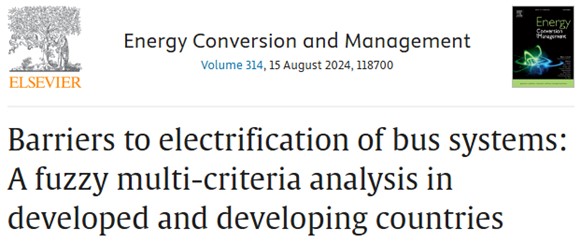Mohammad Sadrani, Razieh Mirqasemi, Alejandro Tirachini, Constantinos Antoniou
Abstract
Public transportation agencies have prioritized transitioning to battery electric buses to enhance sustainable urban mobility. However, this transition faces barriers of various dimensions, including technological, economic, social, management, and environmental aspects. This paper develops a multi-criteria decision-making approach to identify and rank barriers to battery electric bus adoption. First, an evidence-based list of 28 barriers is introduced through an extensive literature review and expert interviews. Then, by designing a fuzzy best-worst method, a structured approach is developed to quantify the weights of these barriers and delineate their relative challenging levels. Besides, a cross-country comparison of barrier weights is conducted between developed and developing countries, utilizing data collected from a diverse panel of experts across 31 countries worldwide. The results highlight the economic aspect (weight: 0.291) as the most challenging barrier worldwide, followed by the technological aspect in developed countries (weight: 0.277) and the management aspect in developing countries (weight: 0.252). The most significant difference in barrier weights between developed and developing countries is observed in management. Range limitation (weight: 0.051), high electricity tariffs (weight: 0.050), and challenges in selecting suitable charging technology (weight: 0.037) are specific barriers exhibiting larger weights in developed countries, while lack of financing options (weight: 0.051), lack of plans to remove diesel bus stock (weight: 0.038), lack of expertise (weight: 0.034), and existence of an informal transit sector (weight: 0.024) are specific barriers receiving larger weights in developing countries. The findings are discussed to offer strategic recommendations for tackling high-priority barriers and accelerating battery electric bus adoption.
